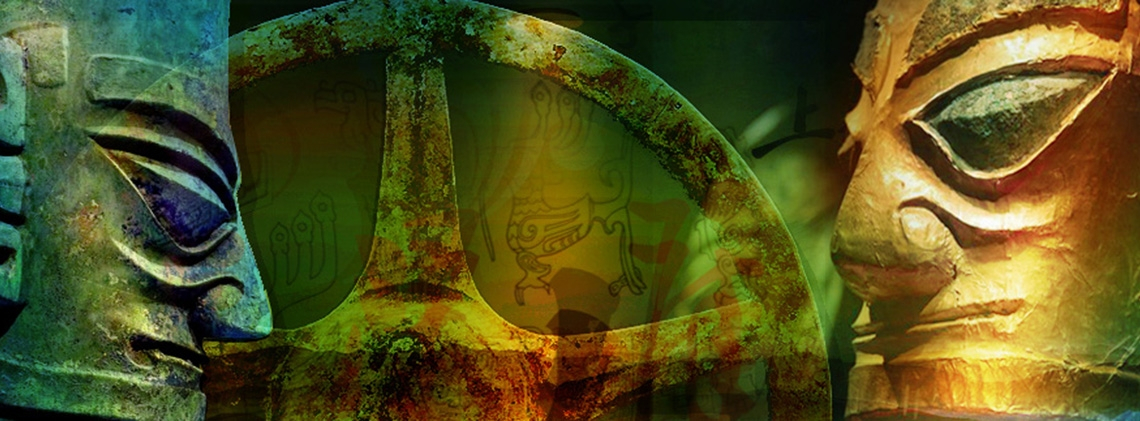
Mysterious Sanxingdui
Splendid
Chi Culture
Topic
Mysterious Sanxingdui
 Listen to this article
Listen to this article
The Sanxingdui (“three-star mound”) site, located in Sanxing village, Nanxing township, Guanghan city, Sichuan province, is thirty-eight kilometers north of Chengdu. The entire area covers twelve square kilometers and is the largest ancient Shu culture site in China. It was also the early capital of the ancient Shu kingdom.
In March 1934, Ge Weihan (David C. Graham, 1884–1961) and Lin Mingjun (nd), two professors of the West China University organized an archaeological team to explore the site of Yueliangwan (Moon bay) in Guanghan. The excavations unveiled Sanxingdui culture to the world for the first time. Subsequently, the team uncovered two large sacrificial pits, four city walls, and the Cangbaobao wall (mound), all of which provided important historical data for studying the origin of the ancient Shu and their relationship to neighboring peoples.
Study of the Sanxingdui site revealed an ancient city that was trapezoidal with a wide southern and a narrow northern end: the east and west walls were 2,100 to 1,600 meters long, respectively; and the southern wall was 2,000 meters long. There was no northern wall as the city was bordered on the north by the Jian River. The entire existing area of the ancient city covers 3.6 square kilometers. There are four important cultural sites around the central axis of the ancient city: Sanxingdui, Yueliangwan, Zhenwu palace (True warrior palace), and Xiquankan (West spring bank). A jade pit as well as two major sacrificial pits were found above this area. Along this axis, one can see that the ancient city was composed of a workshop area, palace area, burial area, sacrificial area, living area, river water supply, and transportation area.
Based on the previously unearthed artifacts and stratigraphic correlation, archaeologists have set the age of Sanxingdui culture between 5,000 and 2,600 years ago with four distinct phases.
The strong local characteristics of the Chengdu plain greatly influenced Sanxingdui culture and fostered its distinctive pottery and exquisite bronzes.
A wide variety of pottery shapes have been found at Sanxingdui:
- dou (a type of stemmed bowl) with foot ring
- various guan-jars with small flat bottoms, pointed bottoms (like an amphora), two-handled, or high-necked
- ladles decorated with modeled heads of birds, horses, or goats
- he-tripods for warming wine
- wine bottles
- hu-pots, some with long necks, some with foot rings
- bei-cups
- die-saucers
- pan-plates, some with foot-rings
- weng-urns
- gang-vats
- tripod-shaped cooking vessels
Among these earthenware, the first three types appear to have been the most popular.
Bronze vessels can be summed up in four words: tall, large, unusual, and extraordinary. Based on shape, they can be divided into various types:
- ritual containers
- weapons carried by honor guards
- human figures
- human heads
- masks, and other human modelling
- animal and plant modelling
- sun-shaped objects
- eye-shaped pieces
- objects intended for shrines
- insects and seashells,
- yuan–round flat pieces with a large hole in the center
The techniques of bronze modelling include painting, clay sculpting, mold turning, smelting, casting, and polishing. The technique used was neat and tidy and the engraving was clear—with a quite simple outline to depict vivid and emotionally complex human figures, as well as plants and animals.
Architecture is neatly divided into two categories: private and palace-style. Private constructions are basically round, square, or rectangular buildings made from materials such as mud, wood, bamboo, or thatch. Builders mostly employed post-and-tie construction and column-and-beam frames with “lifting beams” and mortise and tenon joints. Palace-style construction was on a grand scale, which is evident in the treatment of the foundation—a platform made by applying layers of rammed earth.
The Sichuan Institute of Cultural Relics and Archaeology established a workstation at the Sanxingdui site to protect it. The institute is responsible not only for protecting and excavating the site, but is also responsible for examining and cataloging unearthed objects, and displaying them.



